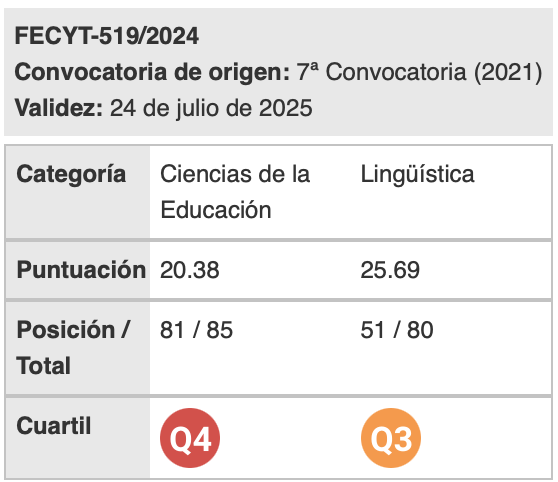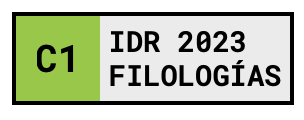An Action-oriented Approach to Didactic Audio Description in Foreign Language Education
Keywords:
audiovisual translation, foreign language education, action-oriented approach, production reception and mediation skills, TRADILEX projectAbstract
This paper introduces the action-oriented foundations of TRADILEX (Audiovisual Translation as a Didactic Resource in Foreign Language Education), a project funded by the Spanish Ministry of Science and Innovation which involves researchers from twelve universities across Europe and the UK. TRADILEX sets out to gather data on the improvement in the linguistic skills perceived through the use of captioning (i.e., interlingual and intralingual subtitling) and revoicing (i.e., dubbing, voice-over and audio description) through an action-oriented approach (AoA). In order to enhance learners’ communicative competence, as well as reception, production and mediation skills in an integrated manner, a methodological proposal for a didactic sequence of audiovisual translation (AVT) tasks has been developed. This methodological proposal is currently being piloted with B1 and B2 adult learners of English as a foreign language utilising – and adapting – the recent illustrative descriptors (Council of Europe 2018) for AVT instruction. This research effort sets out to better understand and evaluate the potential benefits of action-oriented AVT tasks in foreign language education (FLE). This project advocates for a wider integration of AVT in the FLE curriculum, thus fostering visual literacy and mediation skills, whilst promoting an active use of AVT practices and technologies in the classroom.
Downloads
References
Baños, R. and Sokoli S. (2015). Learning foreign languages with ClipFlair: Using captioning and revoicing activities to increase students’ motivation and engagement. In K. Borthwick, E. Corradini, and E. Dickens (eds), 10 Years of the LLAS Elearning Symposium: Case Studies in Good Practice (pp. 203–13). Research-Publishing.net.
Bolaños-García-Escribano, A. and Navarrete, M. (2022). An action-oriented approach to didactic dubbing in foreign language education: Students as producers. XLinguae, 15(2), 103–120.
Bolaños-García-Escribano, A. and Díaz-Cintas, J. (2019). Audiovisual translation. In S. Laviosa and M. González-Davies (Eds), The Routledge Handbook of Translation and Education (pp. 207–225). London: Routledge. https://doi.org/ 10.18355/XL.2022.15.02.08
Burger, G. (2016). Audiodeskriptionen anfertigen – ein neues Verfahren für die Arbeit mit Filmen. Info DaF-Informationen Deutsch als Fremdsprache, 1, 44–54.
Caimi, A. (2006). Audiovisual translation and language learning: the promotion of intralingual subtitles. The Journal of Specialised Translation, 6, 85–98.
Calduch, C. and Talaván, N. (2018). Traducción audiovisual y aprendizaje del español como L2: el uso de la audiodescripción. Journal of Spanish Language Teaching, 4(2), 168–180. https://doi.org/10.1080/23247797.2017.1407173
Cenni, I. and Izzo, G. (2016). Audiodescrizione nella classe di italiano L2. Un esperimento didattico. Incontri, 31(2), 45–60. https://doi.org/10.18352/incontri.10169
Chaume, F. (2004) Cine y traducción. Madrid: Cátedra.
Council of Europe (2001). Common European Framework of Reference for Languages: Learning, Teaching, Assessment. Strasbourg: Council of Europe.
Council of Europe (2018). Common European Framework of Reference for Languages: Learning, Teaching, Assessment. Companion Volume with New Descriptors. Strasbourg: Council of Europe.
Gajek, E. and Szarkowska, A. (2013). Audiodeskrypcja i napisy jako techniki uczenia sięjęzyka – projekt ClipFlair. Jezyki Obce w Szkole. Unijna wieża Babel, 2, 106–110.
Díaz-Cintas, J. (Ed.) (2008). The Didactics of Audiovisual Translation. Amsterdam: John Benjamins.
Fryer, L. (2016). An Introduction to Audio Description. London: Routledge.
Herrero, C. and Escobar, M. (2018). A pedagogical model for integrating film education and audio description in foreign language acquisition. In L. Incalcaterra-McLoughlin, J. Lertola, and N. Talaván (Eds.), Special issue of Translation and Translanguaging in Multilingual Contexts. Audiovisual Translation in Applied Linguistics: Beyond Case Studies, 4(1), 31–55.
Herrero, C. and Vanderschelden, I. (Eds.) (2019). Using Film and Media in the Language Classroom: Reflections on Research-Led Teaching. Bristol: Multilingual Matters.
Ibáñez Moreno, A. and Vermeulen, A. (2013). Audio description as a tool to improve lexical and phraseological competence in foreign language learning. In D. Tsigari and G. Floros (Eds.), Translation in Language Teaching and Assessment (pp. 41–61). Newcastle: Cambridge Scholars Press.
Ibáñez Moreno, A. and Vermeulen, A. (2014). La audiodescripción como recurso didáctico en el aula de ELE para promover el desarrollo integrado de competencias. In R. Orozco (Ed.), New Directions on Hispanic Linguistics (pp. 263–292). Newcastle: Cambridge Scholars Publishing.
Ibáñez Moreno, A. and Vermeulen, A. (2015a). Using VISP (VIdeos for SPeaking), a mobile app based on audio description, to promote English language learning among Spanish students: a case study. Procedia - Social and Behavioral Sciences, 178, 132–138. https://doi.org/10.1016/j.sbspro.2015.03.169.
Ibáñez Moreno, A. and Vermeulen, A. (2015b). Profiling a MALL app for English oral practice: a case study. Journal of Universal Computer Science, 21(10), 1339–1361.
Ibáñez Moreno, A., and Vermeulen, A. (2015c). VISP 2.0: methodological considerations for the design and implementation of an audio-description based app to improve oral skills. In F. Helm, L. Bradley, M. Guarda, and S. Thouësny (Eds.), Critical CALL - Proceedings of the 2015 EUROCALL Conference, Padova, Italy (pp. 249–253). Research-publishing.net. https://doi.org/10.14705/rpnet.2015.000341.
Ibáñez Moreno, A., Vermeulen, A., and Jordano, M. (2016a). Using audio description to improve FLL students’ oral competence in MALL: methodological preliminaries. In A. Pareja-Lora, C. Calle-Martínez, and P. Rodríguez-Arancón (Eds.), New Perspectives on Teaching and Working with Languages in the Digital Era (pp. 245–256). Research-publishing.net.
Ibáñez Moreno, A., Jordano, M., and Vermeulen, A. (2016). Diseño y evaluación de VISP, una aplicación móvil para la práctica de la competencia oral. RIED. Revista Iberoamericana de Educación a Distancia, 19(1), 63–81.
Incalcaterra-McLoughlin, L., Lertola, J. and Talaván, N. (Eds.), (2020). Audiovisual translation in language education. In L. Incalcaterra-McLoughlin, J. Lertola, and N. Talaván. Audiovisual Translation in Applied Linguistics (pp. 1–7). Amsterdam: John Benjamins.
Jenner, M. (2018). Netflix and the Re-invention of Television. London: Palgrave Macmillan.
Lertola, J. (2019). Audiovisual Translation in the Foreign Language Classroom: Applications in the Teaching of English and Other Foreign Languages. Research-publishing.net.
Lobato, R. (2018). Rethinking international TV flows research in the age of Netflix. Television and New Media 19(3), 241–56. doi: 10.1177/1527476417708245
Lobato, R. (2019). Netflix Nations. New York: NYU Press.
Luyken, G.-M. (1991). Overcoming Language Barriers in Television: Dubbing and Subtitling for the European Audience. Manchester: The European Institute for the Media.
Malmqvist, J., Hellberg, K. Möllås, G., Rose, R. and Shevlin, M. (2019). Conducting the pilot study: a neglected part of the research process? Methodological findings supporting the importance of piloting in qualitative research studies. International Journal of Qualitative Methods, January 2019. doi: 10.1177/1609406919878341.
Martínez Martínez, S. (2012). “La audiodescripción (AD) como herramienta didáctica: Adquisición de la competencia léxica.” In S. Cruces, M. Del Pozo, A. Luna, and A. Álvarez (Eds.), Traducir en la Frontera. Granada: Atrio.
Navarrete, M. (2018). The use of audio description in foreign language education. In L. Incalcaterra-McLoughlin, J. Lertola, and N. Talaván (Eds.) Translation and Translanguaging in Multilingual Contexts. Special issue of Translation and Translanguaging in Multilingual Contexts, 4(1), 129–50. doi: 10.1075/ttmc.00007.nav.
Navarrete, M. (2020). Active audiodescription as a didactic resource to improve oral skills in foreign language learning [Unpublished doctoral thesis]. Universidad Nacional de Educación a Distancia.
North, B. and Piccardo, E. (2016). Developing illustrative descriptors of aspects of mediation for the Common European Framework of Reference (CEFR). Language Teaching, 49(3), 455–59. doi: 10.1017/S0261444816000100.
Piccardo, E. and North, B. (2019). The Action-oriented Approach: A Dynamic Vision of Language Education. Bristol: Multilingual Matters.
Schaeffer-Lacroix, E. (2020). Integrating corpus-based audio description tasks into an intermediate-level German course. International Journal of Applied Linguistics, 31, 173–192. https://doi.org/10.1111/ijal.12294.
Sokoli, S. (2006). Learning via Subtitling (LvS). A tool for the creation of foreign language learning activities based on film subtitling. In M. Carroll, H. Gerzymisch-Arbogast, and S. Nauert (Eds.) MuTra Multidimensional Translation Conference Proceedings): Audiovisual Translation Scenarios, Copenhagen 1–5 May (pp. 66–73). Copenhagen: University of Copenhagen.
Sonali, R., Greening J. and Petré L. (2010). A comparative study of audio description guidelines prevalent in different countries. London: Royal National Institute of Blind People.
Talaván-Zanón, N. (2011). A quasi-experimental research project on subtitling and foreign language acquisition. In L. Incalcaterra-McLoughlin, M. Biscio, and M. A. Ni-Mhainnin (Eds.) Audiovisual Translation. Subtitles and Subtitling: Theory and Practice (pp. 197–218). Bern: Peter Lang.
Talaván-Zanón, N. (2013). La subtitulación en el aprendizaje de lenguas extranjeras. Barcelona: Octaedro.
Talaván, N. (2020). The didactic value of AVT in foreign language education. In Ł. Bogucki and M. Deckert (Eds.) The Palgrave Handbook of Audiovisual Translation and Media Accessibility (pp. 567–91) London: Palgrave.
Talaván, N. and Lertola, J. (2016). Active audiodescription to promote speaking skills in online environments. Sintagma: Revista de Lingüística, 28, 59–74. https://doi.org/10.21001/sintagma.2016.28.04.
Vanderplank, R. (1988). The value of teletext sub-titles in language learning. ELT Journal, 42(4), 272–281. doi: 10.1093/elt/42.4.272.
Downloads
Published
How to Cite
Issue
Section
License
Authors who publish with this journal agree to the following terms:
- Authors retain copyright and grant the journal right of first publication with the work simultaneously licensed under a Creative Commons Attribution License that allows others to share the work with an acknowledgement of the work's authorship and initial publication in this journal.
- Authors are able to enter into separate, additional contractual arrangements for the non-exclusive distribution of the journal's published version of the work (e.g., post it to an institutional repository or publish it in a book), with an acknowledgement of its initial publication in this journal.
- Authors are permitted and encouraged to post their work online (e.g., in institutional repositories or on their website) prior to and during the submission process, as it can lead to productive exchanges, as well as earlier and greater citation of published work (See The Effect of Open Access).

Revista de Lenguas para fines específicos is licensed under a Creative Commons Reconocimiento-NoComercial-SinObraDerivada 4.0 Internacional License.

























